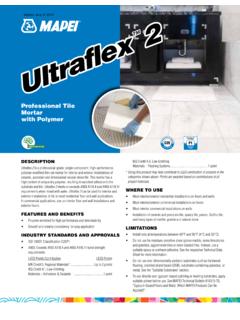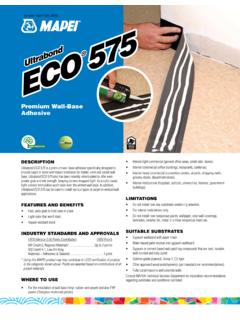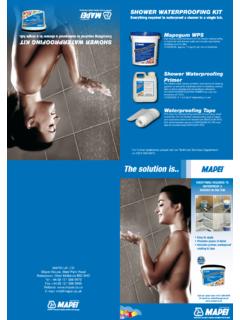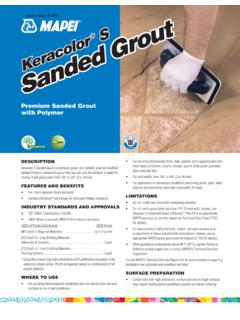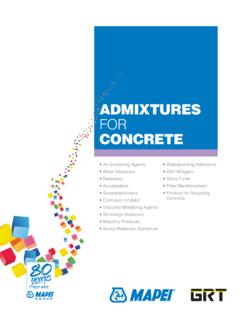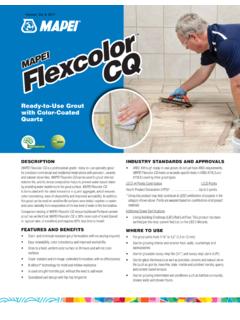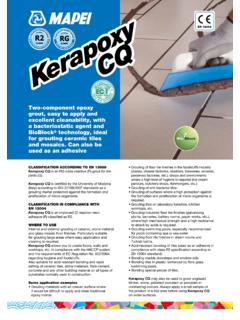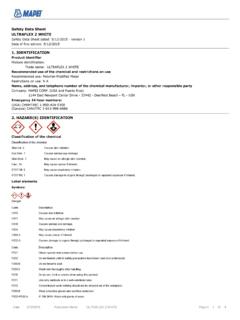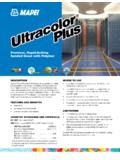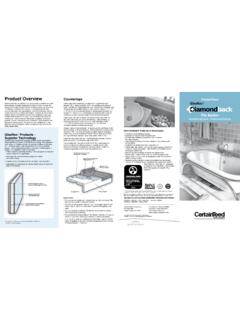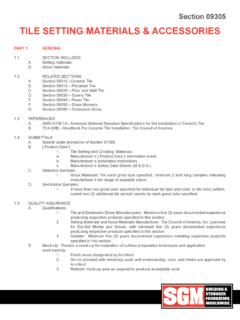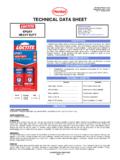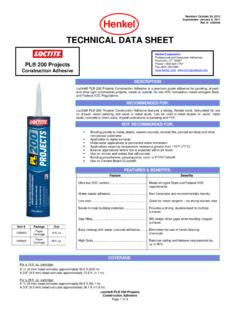Transcription of Two-component acid-resistant epoxy grout (available in 23 ...
1 Two-component acid - resistant epoxy grout (available in 23 colours) for joints of at least 3 mm. Can also be used as an adhesiveCLASSIFICATION IN COMPLIANCE WITH EN 13888 Kerapoxy is a reaction resin (R) grout (G) classified as IN COMPLIANCE WITH EN 12004 Kerapoxy is an improved (2) reaction resin adhesive (R) and slip resistant (T) classified as of Kerapoxy is declared in ITT certificate n 25040322/Gi (TUM) issued by the Technische Universit t M nchen laboratory (Germany) and in ITT certificates n 2008-B-2748 , 2008-B-2748 and 2008-B-2748 issued by the Institute MPA Dresden (Germany).
2 WHERE TO USEI ndoor and outdoor grouting of ceramic tile and natural stone floors and walls. Also suitable for acid - resistant bonding and rapid setting of ceramic tiles, stone materials, fibre-cement, concrete and any other building material on all types of substrates normally used in allows you to create floors, walls and worktops, etc. in compliance with the HACCP system and the requirements of EC Regulation No. 852/2004 regarding hygiene and application examples Grouting floors and walls in the food industry (dairies, abattoirs, breweries, wine-cellars, conserved-food plants, etc.)
3 , shops and areas where hygiene is required (ice-cream shops, butchers, fish vendors, etc.). IN COMPLIANCE WITH EUROPEAN STANDARDS EN 13888 REACTION RESIN grout IN COMPLIANCE WITH EUROPEAN STANDARDS REACTION RESIN adhesive FOR CERAMIC TILES EN 12004 KerapoxyKerapoxyEN 12004 Grouting industrial floors and walls (electrical industries, tanneries, battery rooms, paper-mills, etc.), where high mechanical resistance and resistance to acid attack is required. Grouting swimming pools; particularly suitable for basins containing salt or thermal water. Grouting tanks containing aggressive chemicals (purification plants, etc.)
4 Grouting ceramic tiles on laboratory benches, kitchen work surfaces, etc. acid - resistant bonding of tiles (used as an adhesive in compliance with class R2T specification according to EN 12004 standard). Bonding marble doorsteps and window-sills. Bonding tiles in plastic reinforced by fibre glass swimming pools. Bonding special pieces of CHARACTERISTICSK erapoxy is a Two-component , very low emission of volatile organic compounds, epoxy -resin-based product with silica sand and special components, with excellent resistance to acids and excellent following features are obtained when used correctly: Excellent mechanical and chemical resistance, therefore excellent durability.
5 A smooth final surface with low water absorption, therefore easy to clean; ensures hygiene. Easy workability and finishing. Becomes very hard and is highly resistant to heavy traffic. No shrinkage, therefore absence of cracks and fissures. Uniform colours that are resistant to ultra-violet rays and atmospheric agents. Excellent Because of the tessara s reduced thickness, Kerapoxy can also be used for grouting glass mosaics with joints less than 3 mm. When grouting ceramic tiled floors and walls subject to oleic acid attack ( ham and sausage industries, oil-mills, etc.)
6 And aromatic hydrocarbon, Kerapoxy IEG can be used (available in 113 or 130 reference colour of MAPEI range). For flexible expansion joints or joints subject to movement use an elastic sealant from the MAPEI line ( Mapesil AC, Mapesil LM, Mapeflex PU45 or Mapeflex PU21). Kerapoxy does not ensure perfect adhesion when used for grouting tiles with wet edges or contaminated with cement, dust, oil, grease, etc. Unglazed klinker tiles should be grouted with the same colour tone Kerapoxy. All other colours should be used only with glazed tiles. Do not use Kerapoxy for grouting terracotta tiles because they are difficult to clean.
7 Make preliminary sample tests before grouting porcelain tiles with a contrasting colour of Kerapoxy ( black on white). Always carry out preliminary tests before grouting stone or ground porcelain with a porous or rough surface. Do not add water or any solvents to Kerapoxy to make it more fluid. Use the product in temperatures between +12 C and +30 C. The quantities are already in the correct proportions, therefore mistakes should not be made. Do not guess the quantities when mixing the two components. A wrong catalysis ratio could impair the hardening process. When removing already cured Kerapoxy from the joints, use a hot air industrial drier.
8 Remove hardened Kerapoxy from the tiles with Pulicol 2000. When grouting large floor surface areas, it is recommended to use Kerapoxy P, available in grey 113 of MAPEI range (other colours are available upon request for quantities higher than 300 kg) because it is very fluid and easy to PROCEDUREP reparing the jointsThe joints must be dry, clean, free of dust and emptied at least 2/3 of the tile thickness. The excess adhesive or mortar should be removed while still grouting, make sure that the installation mortar or the adhesive has set and released most of its is not affected by the moisture on the surface; the joints should not be wet during the mixPour all the hardener ( component B), into a bucket containing component A and mix well until a smooth paste is obtained.
9 For perfect mixing and avoiding overheating of the mixture, which could reduce working time, a low speed electric stirrer should be used. Use the paste within 45 minutes from the groutSpread Kerapoxy with the appropriate MAPEI float, making sure the joints are completely filled. Use the same float, but on edge, to remove excess grouting with Kerapoxy, floors and walls should be cleaned immediately, before the product the surface thoroughly and emulsify with an abrasive pad for cleaning joints (such as Scotch-Brite or MAPEI tile-joint cleaning kit), making sure not to wash-out the joints.
10 When cleaning walls, the cleaning pad should be fully soaked with water. The excess liquid can be removed with a hard cellulose sponge ( MAPEI sponge), and should be replaced when too full of resin. Use the same type of sponge for the final tooling of the is very important that once the finishing process has ended, no traces of Kerapoxy KerapoxyKerapoxyGrouting of single fired tile wall with a floatFinishing of single fired tile wall with a Scotch-Brite padFinishing of single fired tile wall with a spongeCHEMICAL RESISTANCE OF CERAMIC TILING GROUTED WITH KERAPOXY*PRODUCTUSEG roupNameConcentration %Laboratory benchesINDUSTRIAL FLOORINGP ermanentlySporadicallyused (+20 C)used (+20 C)AcidsAcetic ++ +(+) ++ Hydrochloric acid37+++ Chromic acid20 Citric acid10+(+)
